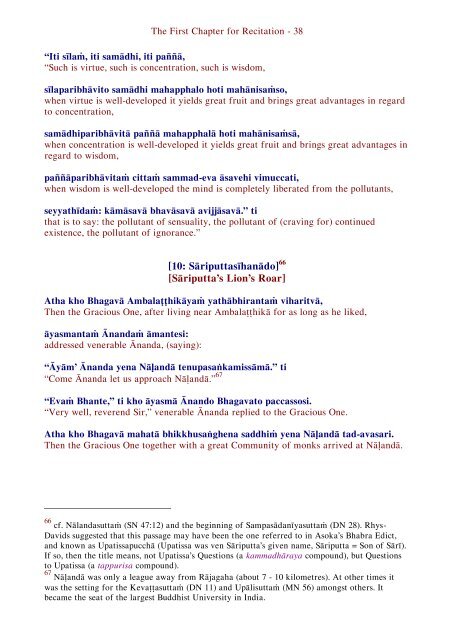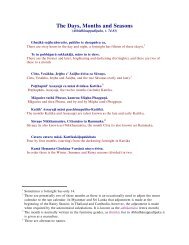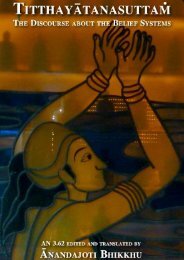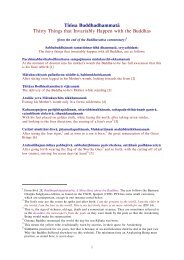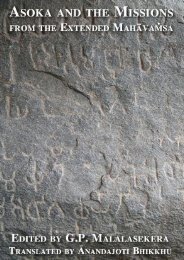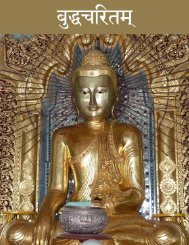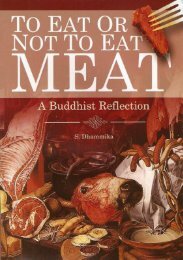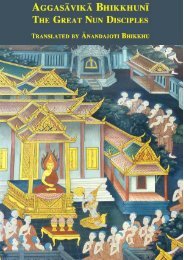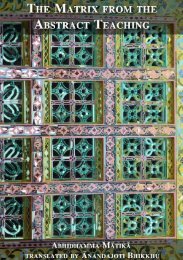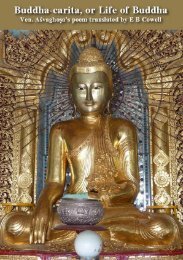Mahaparinibbanasuttam (DN 16) - Ancient Buddhist Texts
Mahaparinibbanasuttam (DN 16) - Ancient Buddhist Texts
Mahaparinibbanasuttam (DN 16) - Ancient Buddhist Texts
You also want an ePaper? Increase the reach of your titles
YUMPU automatically turns print PDFs into web optimized ePapers that Google loves.
The First Chapter for Recitation - 38<br />
“Iti sīlaṁ, iti samādhi, iti paññā,<br />
“Such is virtue, such is concentration, such is wisdom,<br />
sīlaparibhāvito samādhi mahapphalo hoti mahānisaṁso,<br />
when virtue is well-developed it yields great fruit and brings great advantages in regard<br />
to concentration,<br />
samādhiparibhāvitā paññā mahapphalā hoti mahānisaṁsā,<br />
when concentration is well-developed it yields great fruit and brings great advantages in<br />
regard to wisdom,<br />
paññāparibhāvitaṁ cittaṁ sammad-eva āsavehi vimuccati,<br />
when wisdom is well-developed the mind is completely liberated from the pollutants,<br />
seyyathīdaṁ: kāmāsavā bhavāsavā avijjāsavā.” ti<br />
that is to say: the pollutant of sensuality, the pollutant of (craving for) continued<br />
existence, the pollutant of ignorance.”<br />
[10: Sāriputtasīhanādo] 66<br />
[Sāriputta’s Lion’s Roar]<br />
Atha kho Bhagavā Ambalaṭṭhikāyaṁ yathābhirantaṁ viharitvā,<br />
Then the Gracious One, after living near Ambalaṭṭhikā for as long as he liked,<br />
āyasmantaṁ Ānandaṁ āmantesi:<br />
addressed venerable Ānanda, (saying):<br />
“Āyām’ Ānanda yena Nāḷandā tenupasaṅkamissāmā.” ti<br />
“Come Ānanda let us approach Nāḷandā.” 67<br />
“Evaṁ Bhante,” ti kho āyasmā Ānando Bhagavato paccassosi.<br />
“Very well, reverend Sir,” venerable Ānanda replied to the Gracious One.<br />
Atha kho Bhagavā mahatā bhikkhusaṅghena saddhiṁ yena Nāḷandā tad-avasari.<br />
Then the Gracious One together with a great Community of monks arrived at Nāḷandā.<br />
66 cf. Nālandasuttaṁ (SN 47:12) and the beginning of Sampasādanīyasuttaṁ (<strong>DN</strong> 28). Rhys-<br />
Davids suggested that this passage may have been the one referred to in Asoka’s Bhabra Edict,<br />
and known as Upatissapucchā (Upatissa was ven Sāriputta’s given name, Sāriputta = Son of Sārī).<br />
If so, then the title means, not Upatissa’s Questions (a kammadhāraya compound), but Questions<br />
to Upatissa (a tappurisa compound).<br />
67 Nāḷandā was only a league away from Rājagaha (about 7 - 10 kilometres). At other times it<br />
was the setting for the Kevaṭṭasuttaṁ (<strong>DN</strong> 11) and Upālisuttaṁ (MN 56) amongst others. It<br />
became the seat of the largest <strong>Buddhist</strong> University in India.


